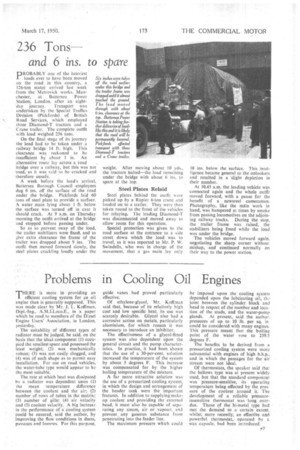236 Tons— and 6 ins, to spare P ROBABLY one of
Page 41

If you've noticed an error in this article please click here to report it so we can fix it.
the heaviest loads ever to have been moved on the •road. in this country, a 126-ton stator arrived last week from the Metrovick works, Manchester, at Battersea Power Station, London, after an eightday journey. Transport was undertaken by the Special Traffics Division (Pick fords) of British Road Services, which employed three Diainond-T tractors and a Crane trailer. The complete outfit with load weighed 236 tons.
On thefinal stage of its journey the load had to be taken under a railway bridge 14 ft. high. This clearance, was reckoned to be
insufficient by about 1 in. An
. .
alternative route lay across a road • bridge over a -railway, but this was not "uSed, as it was said to be cracked and therefore unsafe.
A week before the load's arrival, Battersea Borough Council employees dug 6 ins, off the surface of the road under the bridge. Pickfords laid 60 tons of steel plate to provide a surface. A water main lying about I ft. below the surface was turned off in ease it should crack. At 9 a.m. on Thursday morning the outfit-arrived at the bridge and stopped before passing under.
So as to prevent sway of the load, the trailer stabilizers were fixed, and to give extra clearance the frame of the trailer was dropped about 9 ins. The outfit then moved forward slowly, the sleet plates crackling loudly under the weight. After moving about 10 yds.. the tractors halted—the load remaining under the bridge with about 6 ins. to spare at the top.
Steel Plates Relaid Steel plates behind the outfit were picked up by a Rapier 6-ton crane and loaded on to a trailer. They were then taken round to the front of the vehicles for relaying. The leading Diamond-T was disconnected and moved away to allow room for this operation.
Special protection was given to the road surface at the entrance to a side street down which the load was to travel, as it was reported to Mr. P. W. Swindells, who was in charge of the movement, that a gas main lay only 18 ins, below the surface. This intelligence became general to the onlookers and resulted in a slight depletion in their number.
At 10.45 a.m. the leading vehicle was connected again and the whole outfit moved forward, with a pause for the benefit of a newsreel cameraman. Photography, like the main work in hand, was hampered at times by smoke from passing locomotives on the adjoining railway tracks. During the stop, the trailer frame was raised, the stabilizers being freed while the load was under the bridge.
The vehicles moved forward again. negotiating the sharp corner without mishap, and continued normally on their way to the power station.




























































































